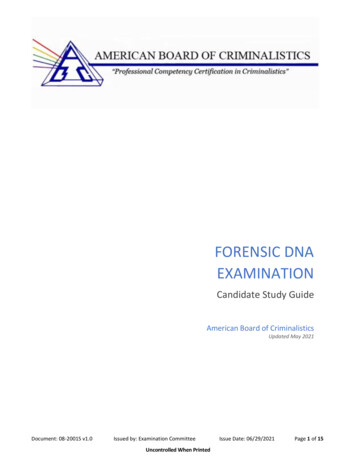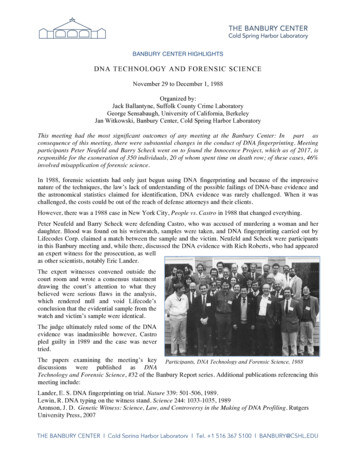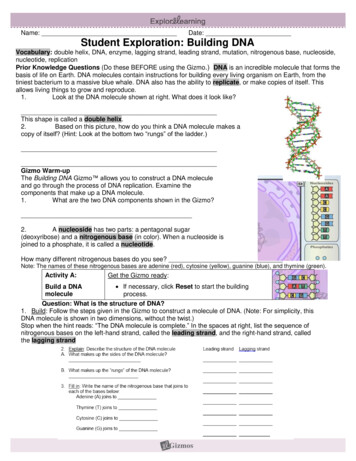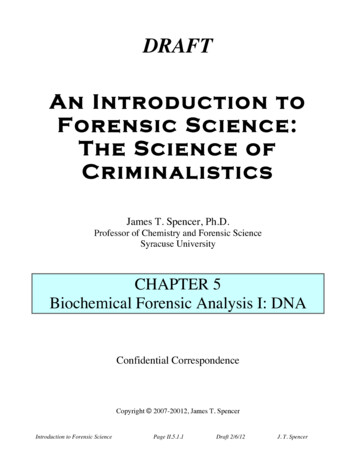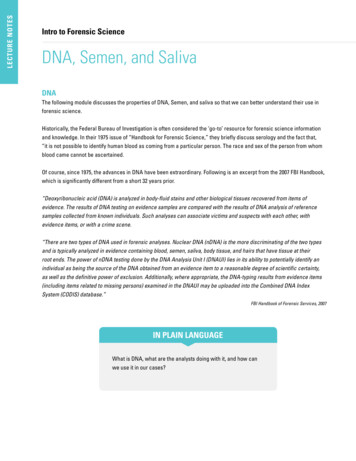
Transcription
LECTURE NOTESIntro to Forensic ScienceDNA, Semen, and SalivaDNAThe following module discusses the properties of DNA, Semen, and saliva so that we can better understand their use inforensic science.Historically, the Federal Bureau of Investigation is often considered the ‘go-to’ resource for forensic science informationand knowledge. In their 1975 issue of “Handbook for Forensic Science,” they briefly discuss serology and the fact that,“it is not possible to identify human blood as coming from a particular person. The race and sex of the person from whomblood came cannot be ascertained.Of course, since 1975, the advances in DNA have been extraordinary. Following is an excerpt from the 2007 FBI Handbook,which is significantly different from a short 32 years prior.“Deoxyribonucleic acid (DNA) is analyzed in body-fluid stains and other biological tissues recovered from items ofevidence. The results of DNA testing on evidence samples are compared with the results of DNA analysis of referencesamples collected from known individuals. Such analyses can associate victims and suspects with each other, withevidence items, or with a crime scene.“There are two types of DNA used in forensic analyses. Nuclear DNA (nDNA) is the more discriminating of the two typesand is typically analyzed in evidence containing blood, semen, saliva, body tissue, and hairs that have tissue at theirroot ends. The power of nDNA testing done by the DNA Analysis Unit I (DNAUI) lies in its ability to potentially identify anindividual as being the source of the DNA obtained from an evidence item to a reasonable degree of scientific certainty,as well as the definitive power of exclusion. Additionally, where appropriate, the DNA-typing results from evidence items(including items related to missing persons) examined in the DNAUI may be uploaded into the Combined DNA IndexSystem (CODIS) database.”FBI Handbook of Forensic Services, 2007IN PLAIN LANGUAGEWhat is DNA, what are the analysts doing with it, and how canwe use it in our cases?
LECTURE NOTESIntro to Forensic ScienceWhat is DNA?Dexoxyribonucleic acid (DNA) is molecular-level information. Other types of evidence can convey meaning based on theirmorphology or form, but this is unseen evidence that is the genetic fingerprint for every living creature. This molecule ispresent in the nucleus of cell and encodes the whole set of information needed for the development and the cycle of lifefor organisms. It’s the instruction book for the cell’s life.DNA is found in many forensically important sources – bodily fluids and tissues, tooth pulp, residue from fingerprints, andso on. Anywhere nucleated cells are, we might find DNA.To begin, please watch the following overview video of the forensic DNA process - https://www.youtube.com/watch?v ZxWXCT9wVoIDon’t worry about knowing all the terminology yet, but this is just to give you an easy introduction into the topic.Human DNAOur DNA is a double helix of about 6 billion paired nucleotides, one set from each parent, forming that familiar twistedladder. Made of a phosphate associated with a sugar, they are linked with one of four organic bases:G/CGuanine (G)T/ACytosine (C)Thymine (T)Adenine (A)The G/C or T/A bases constitute the links between the twosides of the helix chain, or, the rungs on the ladder.The material in the cells of biological evidence is so tiny,that it must be enhanced in order to essentially ‘see’ it wellenough for analysis. Real-time Polymerase Chain Reaction(PCR) is used to amplify the DNA strands so that they can beused.This was mentioned in the introductory video, and also pleasevisits the National Human Genome Research Institute pageat http://www.genome.gov/10000207 for a thorough, but veryeasily understood explanation of the PCR process.Afterwards, watch this short video on PCR denaturing andannealing. https://www.youtube.com/watch?v iQsu3Kz9NYoThe end results of the PCR are exact copies of the targetedareas, called “loci.” 2007 Encyclopedia Britannica, Inc.
LECTURE NOTESIntro to Forensic ScienceWhat are loci?These are noncoding locations along our genome that do not produce proteins. Chosen for ethical and privacy reasons,they create enough of a statistical difference that we can be mathematically excluded/included as the contributor of thatgenetic material.Beginning in 1996, the FBI Laboratory launched a nationwide forensic science effort to establish core STR loci for inclusionwithin the national database known as CODIS (Combined DNA Index System). The 13 CODIS loci are CSF1PO, FGA, TH01,TPOX, VWA, D3S1358, D5S818, D7S820, D8S1179, D13S317, D16S539, D18S51 and D21S11. These loci are nationally andinternationally recognized as the standard for human ages/codis.jpgRead this open letter from the Scientific Working Group on DNA on the subject of loci. er%20APPROVED%2001172013.pdfDo you think the SWGDAM successfully defended the use of the 13 loci?
LECTURE NOTESIntro to Forensic ScienceWhat about identical twins?The genetic profile of identical twins will be the same on the surface level, however researchers have been able to godeep into the genome to find differences – read more about it here. -same-crime-after-DNA-breakthrough.htmlIdentical twins might even have nearly identical fingerprintsGel ElectrophoresisNow that we have an understanding of the structure of DNA, DNA loci, and PCR we can better understand how it can beused for Identification purposes. Central to DNA identification is Gel Electrophoresis, which is a technique that separatesDNA segments based on size and produces a particular pattern unique to an individual.The scientists at Simon Fraser University Museum of Archaeology and Ethnology in BC, Canada explain the processfurther:“Another technique called gel electrophoresis separates the different DNA parts based on size. The sample is searchedfor special areas of DNA that repeat themselves. Although humans share over 99% of their DNA, these particularsegments, called Short Tandem Repeats (STR), vary between individuals. Because a person inherits different genes fromeach parent, every individual has a particular set of STR markers and the chance of two unrelated people having thesame pattern is very low. As a result, DNA ‘profiles’ can be used to assist in the identification process. For example, sexidentification is an important part of generating a DNA profile. To determine sex from nDNA, analysts use the fact thatfemales have two X chromosomes and males have one X and one Y chromosome to target genes that differ betweenmales and females. Three common techniques in forensics focus on the SRY gene, the amelogenin gene and repetitivesequences on the Y-chromosome (Y-STR). The SRY gene is responsible for the development of a fetus into a male. As aresult, its presence suggests a male individual, while its absence suggests a female. The amelogenin technique targets a
LECTURE NOTESIntro to Forensic Sciencegene that is found on both the X and Y-chromosomes. However, the gene sequence is longer in males than females andonce visualized, the length can be used to determine the sex of the individual. The Y-STR technique targets DNA on thenuclear genome specifically. This technique looks for short repeats of the Y-chromosome that are only present in males.Since males inherit this portion of their Y-chromosome from their fathers, this technique can be used to test paternalrelationships.”Watch the complete process video at https://www.youtube.com/watch?v ZxWXCT9wVoICONSIDER THISPotential ProblemsAt least 0.6 ng of DNA is necessary to produce a DNAprofile of good quality, which means that around 100 cellsare required. If such a small quantity of DNA is collectedand later profiled, what does it mean to have found so lowan amount of material?Is the DNA found relevant to the case at hand?Doesn’t it pose a risk that someone unrelatedto the case could have touched the iteminnocently?Touch m/files/legacy/u763/art81210 image1.jpgRead the following and watch the accompanying video for the basic explanation of touch DNA and its uses in tro/index.ssf/2014/10/touch dna police harness advan 4/10/60-second know-it-all touch dn.htmlAlso read the following for excellent explanations of “touch” DNA: Minor 2013. Touch uch-dna-crime-scene-crime-laboratoryWilliamson 2011. Touh /Williamson.pdf
LECTURE NOTESIntro to Forensic ScienceIn the absence of nuclear DNA our last resort is MitochondrialDNA (mtDNA). Found in the subcellular structure of humancells, the mitochondria are small energy factories found ineach cell and have their own genetic material. The mtDNA isa hardy molecule that is sometimes the last biological vestigefor molecular analysis. Unfortunately, it has a far weakerability for individualization than with nuclear DNA for severalreasons:1. Inherited only from the mother during reproduction2. Some nonrelated sequences repeat“TOUCH” DNA AND THE INNOCENTThink about a crime where an innocentperson’s DNA could end up at the scene.Nuclear and mitochondrial DNA differ in important ways. While each cell contains only one copy of nuclear DNA, it maycontain up to 10,000 copies of mitochondrial DNA. In addition, nuclear DNA is a combination both parents’ genes, whilemitochondrial DNA is inherited solely from the mother.The FBI explains the use of mtDNA further, and how they use it – Mitochondrial DNA (mtDNA) is typically analyzedin evidence containing naturally shed hairs, hair fragments, bones, and teeth. Typically, these items contain lowconcentrations of degraded DNA, making them unsuitable for nDNA examinations. The high sensitivity of mtDNA analysisallows scientists to obtain information from old items of evidence associated with cold cases, samples from massdisasters, and small pieces of evidence containing little biological material.Additionally, the maternal inheritance of mtDNA allows scientists to compare a mtDNA profile to reference samples fromthat person’s mother, brother(s), sister(s), or any other maternally related individuals. All of these individuals have the samemtDNA profiles because all maternal relatives inherit their mtDNA from their mother. Because multiple individuals canhave the same mtDNA type, unique identifications are not possible using mtDNA analysis. However, mtDNA performedby the DNA Analysis Unit II is an excellent technique to use for obtaining information when nDNA analysis is not feasible.Additionally, the mtDNA-typing results related to missing-person cases may be uploaded into the CODIS database.”Degradation of DNADegradation refers to the breakdown or destruction of cellular structures after death. Because DNA is contained in thecell, exposure of tissues to the environment, fire, water or chemicals will eventually lead to the physical breakdown of theDNA strands and the alteration of its chemical structure. These changes can lead to incorrect assignments of base pairsand the incorrect identification of a species or individual.If a sample is very degraded, DNA analysts must be careful to ensure they are testing the right material. Importantly,samples must be collected and extracted without contaminating them. Because everyone has it, if a sample is mishandled,DNA that does not belong to the target sample (for example from a police officer) may be detected instead. This couldresult in a false profile.In addition, every analysis must be repeated more than once to control for random chemical changes. Overall, DNA testingfacilities must be extremely clean and follow strict protocols to ensure that the results obtained are accurate.Simon Fraser Universtiy Museum of Archaeology and Ethnology in BC, Canada
LECTURE NOTESIntro to Forensic ScienceReference, or “Known” SamplesJust collecting and analyzing DNA froma crime scene is not enough, as we musthave a source to link the informationback to. Buccal (cheek cell) swabs fromsuspects, witnesses, victims, or otherinvolved persons are an easy way toobtain a known sample. Blood draws areanother option.In missing person cases, what might youlook for in order to get DNA from yourvictim? Examples may include: rootedhair from a brush, a toothbrush, l/documents/images/dna-tests.jpgor clothing known to be worn by the victim,or swabs from any item linked closely to thevictim, such as a cell phone/computer, vehicle,wallet or purse, a desk phone at their workplace, or tools in the garage. Think outside the box!In the end we hope to find a link between the crime scene DNA evidence collected and the known samples in the case.The DNA analysts generate detailed reports and statistical probabilities as to the linkages between the evidence. Theinformation is added to the appropriate CODIS databases for reference as well.Read more about CODIS (FAQs) here: /codis/codis-and-ndis-fact-sheet
LECTURE NOTESIntro to Forensic gCODIS Indices:“In its original form, CODIS consisted of two indices: the Forensic Index and the Convicted Offender Index. The ForensicIndex contains evidentiary profiles developed from biological material such as semen, saliva, or blood found at crimescenes. The Convicted Offender Index contains profiles of individuals convicted of crimes specified by State laws. All50 states have passed DNA legislation authorizing the collection of DNA profiles from certain convicted offenders forsubmission to CODIS. In recent years, CODIS has added new indices: the Arrestee Index, the Missing or UnidentifiedPersons Index, and the Missing Persons Reference Index. CODIS automatically searches across these indices for apotential match to aid criminal investigations of crimes from which unknown biological evidence has been recovered. It isimportant to note that if a hit is obtained from a convicted offender or arrestee sample, the hit is typically used as probablecause to obtain an additional DNA sample from that suspect so that the match can be confirmed by the crime laboratorybefore an arrest is .phpAn extraordinarily unusual case in California is an example of the fears that some in law enforcement have concerninggiving up their DNA - if their profile is found in a case, they may be considered as a suspect, even if contamination is amore likely culprit. In this particular murder, there may be evidence that the lab analyst was in fact the perpetrator, but theinitial suspicions of DNA cross-contamination remain.Please read the following news stories regarding the case, or check the Internet for more recent -contaminated-in-cold-case
LECTURE NOTESIntro to Forensic ScienceLooking FurtherDNA lab personnel are required to give their own biological profiles in order to eliminate them from any instances ofpossible accidental contaminations.THINK ABOUT ITCurrently, most law enforcement agencies, even though they areasking their officers to collect DNA samples at crime scenes, areNOT asking them to be part of an elimination bank. Under whatcircumstances could this cause a problem when evidence isanalyzed?
LECTURE NOTESIntro to Forensic ScienceSEMENWhat is Semen?Semen is a mixture of various fluids that carry livespermatozoa to the female ovule for fertilization. A fertilesemen sample holds tens of millions of spermatozoaper milliliter and can provide useful DNA evidence. Thevolume of ejaculate is anywhere between 2-6 milliliters,with roughly 100-150 million spermatozoa in each mL.Because of illness, drug use, or injury, the sperm countmay be lower.The main constituents of semen: Solid components Sperm Miscellaneous solids, like skin cells Fluid component Seminal plasmaThe solid fraction is primarily the spermatozoa themselves, plus any fragments thereof and miscellaneous skin cellsshed along the way. Seminal plasma contains proteins, salts, organics (including flavins which are the source of its UVfluorescence, and choline), and some cellular material.The components originate from several sources, including seminal vesicles and the prostate gland. The prostate is thesource of the enzyme acid phosphatase (AP) and the protein prostate specific antigen, or p30 protein.Exploitable semen for analysis can be detected up to: 31 hours in the mouth 44 hours in the anus 110 hours in the rectum 10 days in the vagina 19 days in the cervixRead the Davies and Wilson article on “Persistence of Seminal Constituents in the Human Vagina”.Confirming Semen?This is done through microscopy and stained identification of sperm cells. An article on three staining methods of semen isattached here for further reading. “Cytological Detection of Spermatozoa: Comparison of Three Staining Methods”Vasectomized males require other tests targeting known components of semen. Obtaining DNA from aspermatic samplesis possible, but less successful. On aspermatic men, a prostate specific protein, or p30, test may be used to confirm semen.
LECTURE NOTESIntro to Forensic ScienceCommon Semen TestsThe easiest and least intrusive to the evidence is the Alternate Light Source. UV light and the ALS detect seminal stains byphosphorescence and luminescence of the various materials in the semen.Also very easy is the presumptive test for the enzyme, acid phosphatase (AP). Many animal and vegetable tissues have AP,but it is a very high concentration in semen.Both of these are extremely easy to use in the field or at the lab, and both are looking at fluid portion, not solids.JUST IN CASE YOU ARE WONDERINGThe AP tests are significantly less expensive than the p30 tests(roughly 4 each vs. 16 each). They are both good for screening,so if your state lab is going to confirm anyway, it may be morecost effective to do a simple AP test, even though there’s somecross reactivity.Alternate Light SourceAs we mentioned in a previous module, theAlternate Light Source is our first step. It workson the principle that most items will haveluminescent qualities at certain wavelengthsof light, and a band pass filter allows only thatwavelength to reach our eyes/the camera.Using ALSThe alternate light source is the least destructivetechnique we have (other than plain white light).Use it to save yourself time and effort locatingstains. Be sure you understand how it works andwhy it works before going to court. Remember,while we examine the items with ALS, we mightmark it lightly with a sharpie, since once were in regular light, we may not be able to see the stain any longer.When using ALS, the flavins and bacteria in seminal fluid cause the glow. Drops and stains can have a distinctive ring atthe outer perimeter, caused by the migration of the fluid out through the material or on the surface. Smears are still bright,but without the ring. Best in UV light or range just above.
LECTURE NOTESIntro to Forensic ScienceTesting for Semen using Acid PhosphataseALS examination is obviously the first step. However, all stains that fluoresce are not necessarily semen and not all semenstains will fluoresce. Acid Phosphatase testing is easy, fast, and inexpensive. If you have lab capabilities, you can actuallymix your own from reagent powder. But for field-testing, there are several kits.WHITE LIGHTUV LIGHTBELTPLASTICT-SHIRT
LECTURE NOTESIntro to Forensic ScienceThe Chemistry Behind Acid PhosphataseThe AP spot test contains sodium-α-naphthyl phosphate ando-dianisidine (Brentamine Fast Blue). If acid phosphatase ispresent in a sample and a drop of the reagent is added, the enzymecatalyzes the sodium-α-naphthyl phosphate producing freenaphthyl. That reacts with o-dianisidine producing a purple coloredcompound.Please read the Laux article “Forensic Detection of Semen I. TheAcid Phosphatase Test”Are There False Positives?Of course there are false positive. Feminine products, fecalstains, plants, pregnant women and prepubescent girls are allpotential intereferences with the test. But remember, semen is aheterogeneous fluid and a single stain will contain various levelsof acid phosphatase, P30, and sperm. Since AP can be found inlower levels in other bodily fluids, it’s important to view the testimmediately and report it accurately.Time Frame for TestingHow long would you expect to find the following in the vagina after intercourse?Acid Phosphatase is detectable for approximately 72 hours after intercourse and sperm can be found approximately 3 to 5days depending on activity after the assault.Testing Other ItemsHow long would you expect to find AP in a dried stain, such as clothing or bedding?AP may survive for many years in a dried state; however, environmental conditions (heat, moisture, bacterial growth) couldaffect the survival rate.
LECTURE NOTESIntro to Forensic ScienceReporting Your Result“A swab of the unknown substance was tested withthe AP spot test and gave a positive presumptive result,indicating the substance may be seminal fluid.”Or“Analysis of gave presumptive chemicalindications for the presence of acid phosphatase, acomponent of semen.”In court, explain in a similar manner to the KM test – it’s a color change based on the chemicals reacting to a substance inseminal fluid.Watch the video demonstration of the AP field test in the module course page.Perform your own tests using the wheat germ AP and the test kit.Several 2012 studies explored the possibility of letting the test reaction be read after the standard two-minute mark.Please read the Redhead and Brown 2012 article “The acid phosphatase test two minute cut-off: An insufficient time todetect some semen stains.”
LECTURE NOTESIntro to Forensic ScienceSALIVAWhat is saliva?Saliva is a biological secretion inside the mouth that isprimarily a digestive aid as the salivary amylases breakdown the starches in our food. It contains urea, glucose,progesterone, various traces of acids, amino acids, creatinine,and more than 1,000 different proteins. No specific test existsfor its detection, although the presence of alpha-amylasestrongly supports the identification of saliva.Additionally, saliva is a carrier of cells for genotyping. Cellsmight be found on stamps, food, drinking glasses, cosmetics,pillows, bite marks on skin, and so forth.Saliva is secreted from three sets of glands; the sublingual,submandibular, and parotid.Screening for saliva is based on detection of high levels of amylase in the sample. It is not a confirmatory test as amylaseis found in other body fluids.What’s in Your Spit?Your spit contains mostly water, but bacteria, skin cells from the inside of the mouth (buccal cells), and the substance wetest for – α-amylase – is also present. This enzyme helps break down carbohydrates, but can vary widely between people.Studies have also suggested that vegetarians and people from cultures that consume a high carbohydrate diet may havehigher levels of amylase than others. In a completely non-scientific local experiment, two CSIs who came from CentralAmerican and East Indian heritages and ate often of their cultures’ foods (corn, beans, breads, rices, etc) had strongerreactions in testing than a Caucasian CSI who was avoiding starchy carbohydrates and eating primarily meats, nuts, andvegetables.The Breslin 2013 article on “An Evolutionary Perspective on Food Review and Human Taste” begins a discussion of thepossible evolutionary aspects of this on page 6.Also found in other bodily fluids, so again, not a confirmatory test!
LECTURE NOTESIntro to Forensic ScienceSaliva and the ALSSaliva visually represents with soft edged white spots, sometimes less intense than other stains because of fewer solids.Saliva under UVWHITE LIGHTUV LIGHTROBBER MASKPAPER
LECTURE NOTESIntro to Forensic ScienceTesting for SalivaWe’re going to look at a lab technique for the RSID-Saliva kit. Be careful when deciding todo this test though, since case information may indicate sending an item off for DNA analysismight be better.The RSID Saliva test is specific for human salivary α-amylase.No cross-reaction has been observed with blood, semen, urine, vaginal secretions, ormenstrual blood.RSID test is kind of like a pregnancy test. You’re going to get two stripes for positive, or onefor negative.Saliva50 µl of salivaextracted in 1ml PBSExtract0µl1µl5µl10µl20µl
LECTURE NOTESIntro to Forensic ScienceLateral Flow Immunochromatographic Strip Tests for the Bdentification of body Fluids Using the RSID-Saliva TestFirst specific, non-enzymatic tests for salivary amylase. No observed cross reaction with blood, urine, sweat, semen,domestic animals, exotic species, body fluid mixtures. Minor, but consistent signals seen with breast milk and fecalsamples. Fast: Test results in 10 minutes post extraction. Sensitive: Detects as little as 50 ml of saliva – stated detectionlimit: 1 ml. No High Dose Hook effect observed: little or no dilution required, less possibility of false negatives. Efficient:Assay procedure integrated in DNA-STR analysisRSID-Saliva should be evaluated exactly 10 minutes after the addition of sample.A visible red line at the Control (C) position only, indicates a negative result. No α-amylase detected.Visible red lines at both the Control (C) and Test (T) positions, indicate a positive result. Α-amylase detected.A visible red line at the Test (T) position only, indicates a failed test. Test failure, no conclusion possible.No cross reactivity has been observed with saliva from the following animals and pets: dog, opossum, guinea pig,woodchuck, cow, domestic cat, domestic rabbit, tokay gecko, cuckoo, mongoose, chameleon, domestic pig, llama, sheep,horse, goat, grey gull, ferret, hedgehog, skunk, lion, tiger, rhinoceros, marsh snake, Sykes monkey, Capuchin monkey,tamarin, and marmoset.A positive signal was obtained from the saliva of gorilla.Read more about RSID here. Old et al. 2009. Developmental Validation od RSID-Saliva: A Lateral FlowImmunochromatographic Strip Test for the Forensic Detection of Saliva.So next, we’ll do a little demo. There is no hands-on or written component for this particular lab. Please just watch theassociated video in the course page.Fun with the RSID-Saliva kitThe lab version does require a pipetter with a low setting, however there is also a ‘field friendly’ kit.So why show it here, because it can be done with just a little training and understanding of the process. And, since it’s abit more advanced than average, it can be intimidating. We’re here to see it’s actually not that scary.CONCLUSIONThis module has covered the properties of biological evidence including DNA, Semen, and Saliva and the detection ofthese substances.
forensic science. Historically, the Federal Bureau of Investigation is often considered the ‘go-to’ resource for forensic science information and knowledge. In their 1975 issue of “Handbook for Forensic Science,” they briefly discuss serology and the fact that, “it is not possible to identify human blood as coming from a particular .File Size: 698KB

